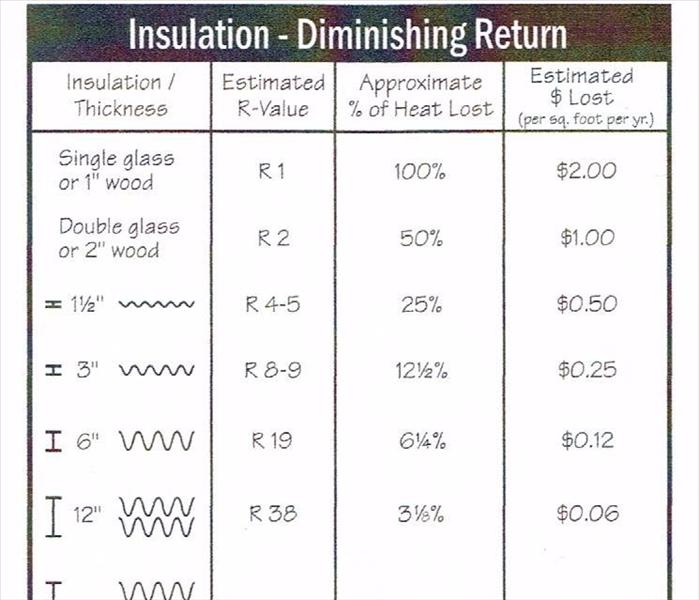Week 4 Question - Scavenger Hunt Contest Fall 2014
10/27/2014 (Permalink)
Have you felt the chill in the night air lately? Most of us know that our homes are insulated and that insulation makes homes more energy efficient. The efficiency of insulation is measured in what is called an "R Value". The higher the value, the more it will protect against heat loss. But what does the "R" stand for?
A. Reflection
B. Reduction
C. Redirection
D. Resoluteness
E. Resistance
Need a hint? "Hunt" for the answer in the article below!
We all know that insulation makes our homes more energy efficient. But how much should you have?
If the cost to heat and cool your home seems to be out of control, don't worry. You can take control of your energy bills by air sealing and insulating your home. Beefing up the insulating power of your walls, floors and ceilings is well within your grasp, but before you start tearing your house apart, let's cover a few insulation basics.
What is insulation? Insulation in its most basic form is just a means of trapping air, more specifically a gas, in little pockets or bubbles. Insulation works by dividing the space in our walls, floors and ceilings into billions of these tiny air pockets or bubbles. As heat tries to move through the insulation towards the cold, it must warm each bubble independently before moving on to the next bubble or air pocket. This slows down the transfer of heat through your home making it more comfortable and energy efficient.
What kinds of insulation are available? There are basically four types:
1. Blankets of Insulation - This is the most common type fiberglass or rockwood insulation sold in home improvement stores. This cotton candy like insulation earns its R-value by trapping air in between tiny fibers.
2. Blown-in Insulation - Made of cellulose or fiberglass, this type of insulation is sold in compressed blocks which are broken down into tiny pieces by a powerful machine known as an insulation blower. The blower forces the insulation through a large hose. As the insulation flies out of the hose, the installer directs the flow of insulation into place.
3. Spray Foam Insulation - Spray foam insulation is a combination of chemicals which are heated and sprayed out of a machine through a hose. The spray foam chemicals mix together at the tip of the hose creating a thick paint-like goo that sticks to anything it touches including wires, pipes and ducts.
4. Foam Board Insulation - Perhaps the least understood insulation product on the market is known as foam board or rigid insulation. It comes in sheets like plywood or drywall and in thicknesses from 1/2" to 2". Foam board is typically installed on the outside of your home during a major renovation or underneath a concrete floor before its poured.
Insulation is rated by R-Value, or resistance, to heat flow. The higher the R-Value, the greater the resistance to heat transfer. The key to insulation is that it stops convective air flow and therefore stops heat flow. Stop the air flow and you stop the heat flow.
The other key to understanding insulation is that every time you double the thickness of the insulation, you cut heat flow in half. This means, with 3" of insulation, you have about R-9 and a big heat loss. Double that to 6" and you are R-19, cutting your heat loss in half! Double it again to 12", and your R-Value is about 38, and your heat loss cut in half again. But once you get to R-38, you quickly approach the area of diminishing returns; you would have to double the R-Falue again to 76 to cut the heat loss in half -- and at this point there is already very little heat loss.
According to the US Dept of Energy website, the San Francisco Bay area falls into Zone 3, which recommends R-30 to R-60 in the attic.
When considering adding insulation to your home, you'll want to do a little research to locate a contractor who wants to discuss air leakage, bypass, and the thermal envelope. If a contractor doesn't bring up these items, find a better contractor.
Our homes are complicated systems. Spraying a little insulation into an attic may not solve your heat loss and energy cost problems -- it may even cause more problems than it solves. Proper thought and planning are essential in getting the job done right.





 24/7 Emergency Service
24/7 Emergency Service
